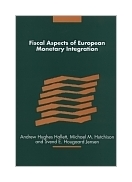|
||
• wydawnictwa polskie
• Zamów informacje o nowościach z wybranego tematu • kontakt
• Cookies na stronie |
FISCAL ASPECTS OF EUROPEAN MONETARY INTEGRATION.HALLETT A. HUTCHISON M., JENSEN S.wydawnictwo: CAMBRIDGE , rok wydania 1999, wydanie Icena netto: Fiscal Aspects of European Monetary IntegrationEdited by Andrew Hughes Hallett, Michael M. Hutchison, Svend E. Hougaard JensenOctober 1999 | Hardback | 362 pages 16 tables 20 figures | In stock Monetary union in Europe started in 1999. The fiscal policy implications are, in many ways, more complex than the monetary issues, yet very little has been written on them. This book contains eleven papers and three review essays, which analyse a spectrum of empirical, theoretical, institutional and political aspects of the design and impact of fiscal policy in EMU. The contributors are some of the most experienced analysts in the field. Topics covered include the need for and consequences of fiscal coordination, constraints on national deficits and debt levels (the Stability Pact), and the role of fiscal federalism and insurance. The importance of coordinating fiscal and monetary policies is also considered in depth. As long as these strategic and institutional aspects remain imperfectly understood, EMU will not be able to function to its full advantage and may suffer periods of instability or weakness. ContributorsAndrew Hughes Hallett, Michael M. Hutchison, Svend E. Hougaard Jensen, Niels Thygesen, Thomas F. Willett, Torben M. Andersen, Robert Dogonowski, Kenneth M. Kletzer, Neil Rankin, Michael Artis, Bernhard Winkler, Roel M. W. J. Beetsma, Peter McAdam, Clas Wihlborg, Michael Bergman, Christopher Allsopp, Warwick McKibben, David Vines, Giancarlo Corsetti, Paolo Pesenti, Paul De Grauwe Contents1. Fiscal aspects of European monetary integration: an introduction Andrew Hughes Hallett, Michael M. Hutchison and Svend E. Hougaard Jensen; Part I. Institutions and Political Economy: 2. Institutions and fiscal policy in EMU Niels Thygesen; 3. A political economy analysis of the Maastricht and Stability Pact fiscal criteria Thomas F. Willett; Part II. Automatic Stabilizers in a Monetary Union: 4. Budgetary norms and EMU Torben M. Andersen and Robert Dogonowski; 5. Regional adjustment and the welfare economics of monetary unification: what are the benefits of exchange rate flexibility and fiscal insurance? Kenneth M. Kletzer; 6. Nominal stability, real convergence, and fiscal transfers in a monetary union Svend E. Hougaard Jensen; Discussion: Automatic Stabilizers and Fiscal Transfers Neil Rankin; Part III. The Stability and Growth: Pact 7. The Stability Pact: Trading-off Flexibility for Credibility? Michael Artis and Bernhard Winkler; 8. The stability and growth pact in a model with politically-induced deficit biases Roel M. W. J. Beetsma; 9. Implications of the Growth and Stability Pact: why the growth element is important Andrew Hughes Hallett and Peter McAdam; Discussion: the Stability Pact and Fiscal Policy Clas Wihlborg; Part IV. Asymmetric Business Cycles and Fiscal Linkages in Europe: 10. Costs of EMU and economic convergence Michael Bergman and Michael M. Hutchison; 11. Fiscal consolidation in Europe: some empirical issues Christopher Allsopp, Warwick McKibben and David Vines; 12. Could the ins hurt the outs? a welfare analysis of International Financial Fiscal Links Giancarlo Corsetti and Paolo Pesenti; Discussion: insiders and outsiders in EMU Paul De Grauwe. Księgarnia nie działa. Nie odpowiadamy na pytania i nie realizujemy zamówien. Do odwolania !. |


